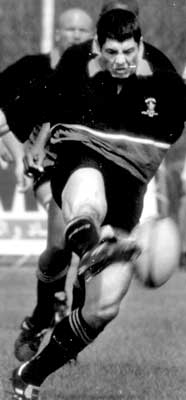
Kick to touchThe school season is on with a few expected hopefuls taking a back seat in terms of wins. It seems that Kingswood , St Peters, Issipatana and Royal are remaining unbeaten. St Anthonys College Kandy and S. Thomas who have lost to St Peters are yet within kicking range. The season which began with uncertainty is progressing in the form of the matches being played. The game is still in a fluid state as far as the schools at the bottom league go.
The games have not produced the rugby that will keep the crowds on their toes. Though there have been a few matches with close finishes, the rugby served to your plate did not seem to inspire to make you come back for a second helping. Probably the weather conditions and the bad lighting could have been contributory factors. It has been slow motion hits that do not give the necessary pep to what is a dull game. At times it has been a woeful inability to hold onto a ball. The three quarter moves have been few and far in between. Yet there have been many breakdowns that have contributed to a lack of flow. . A significant feature of the games that I have seen has been the kicking. The kicking though many have been more speculative than with a purpose. That is what I think when I open my memory bank and revisit some of the matches I have seen. Thought I should therefore share with you some thought on the aspect of kicking for rugby football. Because If you kick in a rugby match it should with a view to win and this must be foremost in your mind when you put boot to sometimes the kicking I have seen seemed to forget that the word rugby goes along with the word football. The kicks therefore need to be for one of three. That is to kick for pressure, to kick for position and or to kick to disrupt. When I applied these to the games witnessed I asked myself whether it was inexperience and youth that made teams kick badly. I thought so till I witnessed the under 24 final where kicking was not at its best though the potential was there. It seems in most matches kicking was left to chance or to the fly half. If it was planned then the question is whether it was practiced. Else how could you otherwise justify the poor kicking? The high ball: the challenge is to get your chaser to meet the ball and their catcher at the same time Then force an error such as a knock on or a dropped ball, force a ruck or maul, or more likely force the defenders to quickly kick away the ball, probably into touch.. The wiper kick is a diagonal kick away from the opposing forwards. It is used to drag your opponents around the pitch. Mixing up these two kicks can push your opponent into defending deeper. This can create gaps in their defensive line, particularly since their wingers and full back may have to track back in defense. This requires intelligent kickers who have practiced. This is something we do not see on the field but we see more of those hopefully it will land in a position that will be good for us kick. To kick for position is to get your team to places on the pitch where you want to be. In other words to play to gain area, this includes kicks to the corners are a good way of putting pressure on the opposition and forcing a better position for your team. The challenge of kicking for position is either to get the ball to roll into touch, or force your opponent to field the ball and then possibly give away a lineout as they clear the danger. This tactic requires chasers, and also players who can track back to field any return kicks. Usually teams only kick for position in their opponent’s half. Kicking for disruption is yet another art in the kicking field. Chip kicks, grubber kicks and cross kicks are ways of “kicking over” your opponent’s defense with the aim of giving yourself an excellent chance of retrieving the ball. This works most effectively when your opponent’s defensive line has been difficult to break down and you want to create some forward momentum. Now look at the game that sees so much kicking from his perspective and then judge for your self. If it does not meet the purposes I have mentioned then why are they kicking so much? May be to play at the top level and be ready to stay away from the big boys to whom Sri Lanka is losing badly. If that is so you have my sympathies. |
|| Front
Page | News | Editorial | Columns | Sports | Plus | Financial
Times | International | Mirror | TV
Times | Funday
Times || |
| |
Copyright
2007 Wijeya
Newspapers Ltd.Colombo. Sri Lanka. |
